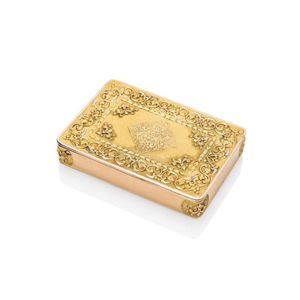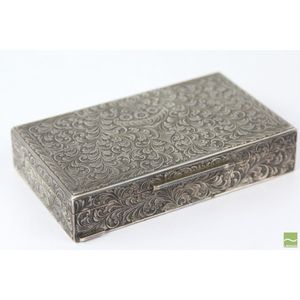William Comyns Embossed Silver Jewel Casket, London 1902
You must be a subscriber, and be logged in to view price and dealer details.
Subscribe Now to view actual auction price for this item
When you subscribe, you have the option of setting the currency in which to display prices to $Au, $US, $NZ or Stg.
- Embossed / Repousse - Embossing, also known as repousse, is the technique of decorating metal with raised designs, by pressing or beating out the design from the reverse side of the object.It is the opposite of chasing, where the decoration is applied from the front. An embossed or repoussed object may have chasing applied to finish off the design.
- Sterling Silver - Sterling silver is a mixture of 92.5% pure silver and 7.5% of another metal, usually copper. Fine silver is 99.9% pure silver, and is relatively soft and the addition of the very small amount of copper gives the metal enough strength and hardness to be worked into jewellery, decorative and household objects.
- Floral Swag / Garland / Festoon - Floral swags are a decorative motif often used in the ornamentation of various objects, such as silverware, glassware, and furniture. The term "swag" refers to a garland or wreath of flowers, foliage, or other decorative elements, which is usually arranged in a loop or curve.
Floral swags can be found in a variety of decorative styles, from ornate Baroque and Rococo designs to more naturalistic Art Nouveau and Art Deco styles. They are often used to add a touch of elegance, refinement, or whimsy to an object, and can be seen on a range of items from chandeliers and candlesticks to picture frames and tea sets.
In the decoration of silver objects, floral swags are often used to accentuate the curves and lines of the piece, and to add visual interest to the surface. Similarly, on glass objects, floral swags may be used to frame or highlight a particular area of the object, or to add a touch of color and delicacy.
On furniture, floral swags can be found on a variety of pieces, from cabinets and armoires to chairs and sofas. They are often used to enhance the lines and curves of the furniture, and can be used to create a sense of movement and flow in the design.
Overall, floral swags are a versatile decorative element that can be adapted to a range of styles and applications, and have been used in the decoration of various objects throughout history. - Edward Vii - Edward VII (1841 ? 1910) was King of the United Kingdom and the British Dominions and Emperor of India from 1901 until his death in 1910. He was the first British monarch of the House of Saxe-Coburg and Gotha, which was renamed the House of Windsor by his son, George V.
This item has been included into following indexes:
Visually similar items

A Russian rectangular tri-colour gold snuff box by Johann Wilhelm Keibel (1788-1862), circa 1830, the hinged cover with an applied diamond shaped section of foliate scrolls on a matt ground surrounded by a border of scrolling yellow and red gold and platin

An Italian fine foliate engraved silver box finely detailed with central urn to hinged lid and flowers with floral scroll work covering the rest of the piece. Hallmarked 800 silver Florence, size height 3.5 cm, width 17 cm, depth 10 cm, weight. 365g.

A Persian silver box made in Isfahan, early twentieth century 18 x 9.5 cm

An Edward VII rectangular sterling silver dressing table tray, Birmingham 1902, 29 x 20 cm
